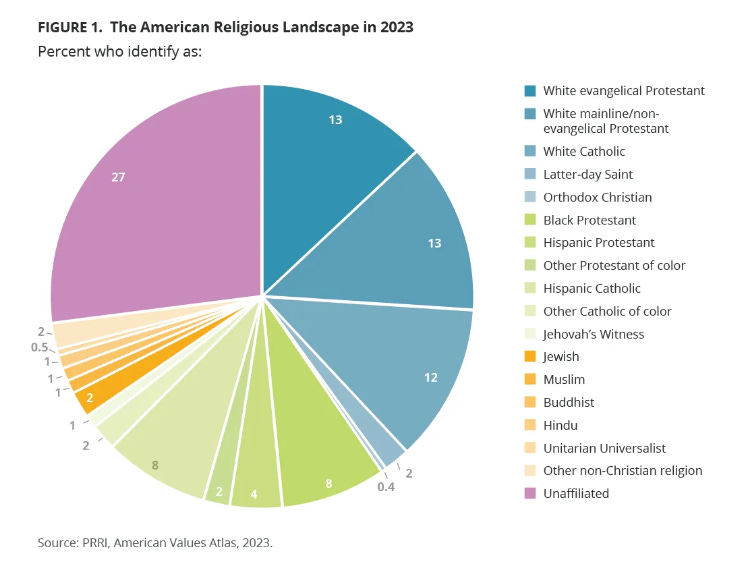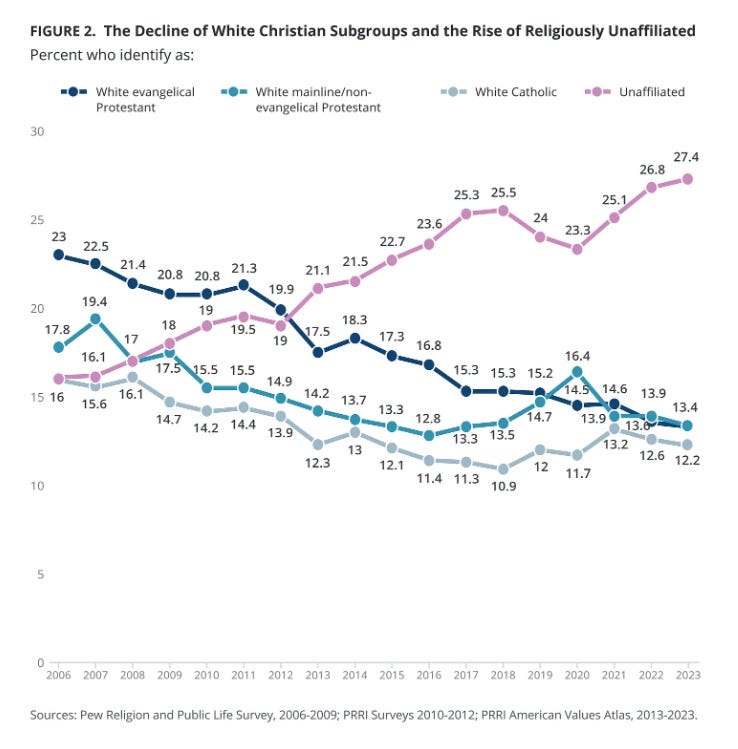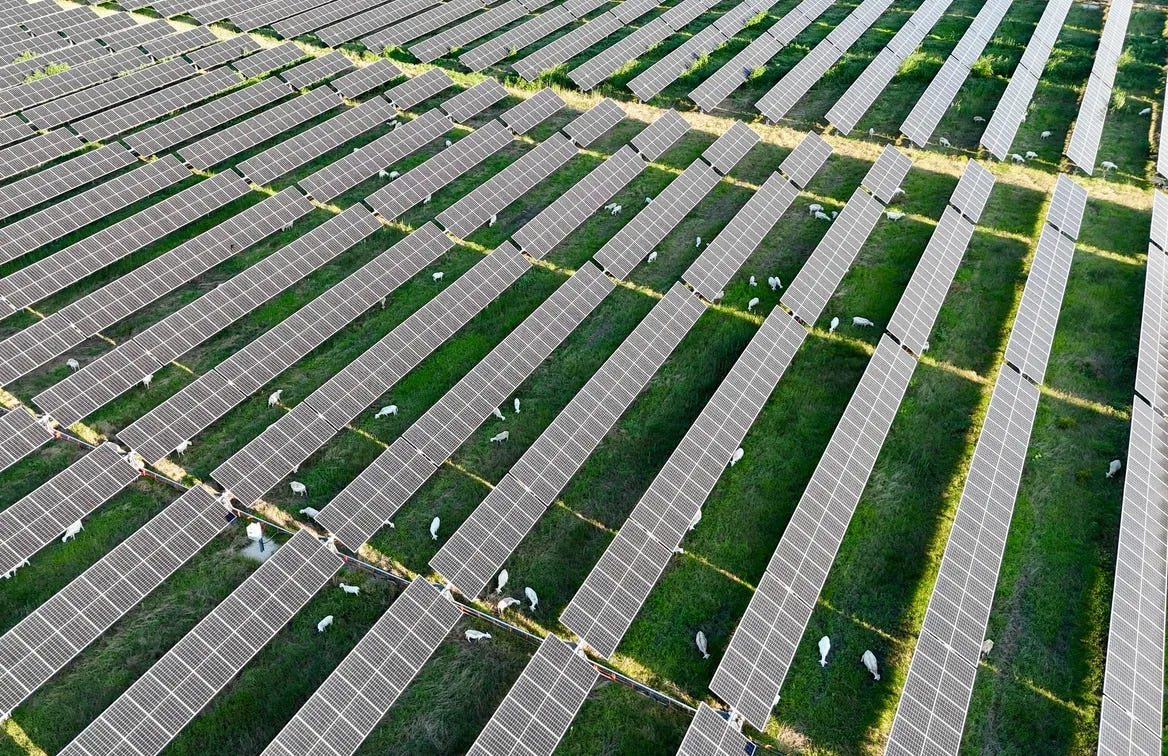Refugia Newsletter #75
China and renewable energy buildout, new research on religion in America, mollusks and sheep infrastructure, and cheeky assessments of summer
Refugia News
Hard to believe this is the 75th issue of this little newsletter. I started writing the newsletter in November of 2021, if you can believe it. Goodness. Thanks to all of you for reading—you are joining me in an effort to help people of faith lean into climate knowledge and action, in order to live out our love for God, neighbor, and the earth. What shall I do when it’s time to celebrate the 100th issue?? Any ideas? We’ve got a year or so to think about it….
The butterfly weed looks as though it’s past its prime, but this hungry little fellow doesn’t think so. Yum! We found four monarch caterpillars today on this plant alone. Also, I’m trying to figure out how all the aphids in the entire state decided to descend upon my native plants in the last couple weeks (those orange rice things are aphids). The ladybug community has apparently been notified, though, because they are starting to turn up to enjoy the aphid feast.
Meanwhile, the academic year has officially begun for me, meaning I will probably be neglecting yard work, garden work, and home maintenance even more than usual, alas. In a few weeks, I look forward to traveling to Maine in order to serve as a keynote speaker for the BTS Center’s Convocation, September 26-27. The theme is “Hope in Small Places: Becoming People of Refugia Faith.” My good friends at the BTS Center are organizing a thoughtfully designed “Online Companions” track so that people can attend remotely (in-person registration is full). You can find more information here.
You might also be interested in joining the BTS Center for their online book study of Brian McLaren’s new book, Life After Doom, with meetings taking place in October and November. In other opportunities, the Evangelical Environmental Network is hosting an online Prayer Service for the Care of Creation on September 5. This is in connection with the ecumenical, worldwide Season of Creation, which runs from September 1-October 4. If you want to know more about the Season of Creation, you can now watch the webinar recently hosted by Creation Justice Ministries in partnership with One Home One Future. This 1-hour video is a great way to “meet” some terrific leaders in the faith/climate space and learn about further resources. Shout-out to my friend Derrick Weston, who is hosting the webinar!
This Week in Climate News
I’m probably crazy, but I’m going to make an attempt at “so what’s going on with renewable energy in China?” A lot, apparently. Let me see if I can make some sense of it in a brief summary. Bottom line: China is ahead of the US in ambitious clean-energy transition. But of course, it’s complicated.
There’s plenty of news coverage to choose from, but we’ll start with this March 13 piece by Isabel Hilton in YaleEnvironment360. Here’s Hilton’s summation: “In a world in which national climate targets are being missed, the speed and scale of expansion in China’s installed renewable capacity is unmatched.”
Let’s put some numbers on that:
When the International Energy Authority issued its assessment of the pledge to triple renewables globally by 2030, it pointed out that the 50 percent increase in global renewable installations in 2023 was largely driven by China. In 2022, China installed roughly as much solar photovoltaic capacity as the rest of the world combined, then went on in 2023 to double new solar installations, increase new wind capacity by 66 percent, and almost quadruple additions of energy storage.
All this is a deliberate strategy on China’s part: they have set out to be the world leader in the renewable energy transition:
Within a decade, China had largely achieved its goal of dominating not only the production of solar and wind technologies, but it had developed a near monopoly on every aspect of the supply chains, including the mining and processing of the rare-earths and strategic minerals essential for the clean energy revolution. Today, China has more than 80 percent of the world’s solar manufacturing capacity.
China is also pumping out EVs like crazy, with the world’s largest EV manufacturer, BYD. Why aren’t we seeing BYD cars in the US? Short answer: tariffs, which are giving the US EV industry a chance to build up.
As many critics point out, and as China is well aware, they have also become the world’s largest carbon emitter, for reasons outlined in detail in Hilton’s article. Mostly it has to do with how much China is still relying on coal.
However, that could change quickly. An August 8 report by Lauri Myllyvirta in Carbon Brief explains that China’s carbon emissions could start dropping soon. And meanwhile, their clean energy expansion keeps expanding. Time for a graph:
This is another illustration of “decoupling”: that is, the fact that it is now possible to grow GDP, grow an economy, without increasing carbon emissions. Increasing wind and solar capacity means China is getting more of its power from renewables: “As a result of the strong capacity growth – and despite poor wind conditions – solar and wind covered 52% of electricity demand growth in the first half of 2024 and 71% since March.”
In fact, this growing capacity, which is outpacing simultaneous growth in energy demands, will mean that demand for coal and other fossil fuels will continue to decrease.
There are lots more details to read about in these reports, factors that tend to slow China’s transition and factors that affect their carbon emissions. Carbon Brief concludes: “Nevertheless, China is likely still on track to begin a structural decline in emissions in 2024, making 2023 the peak year for CO2 emissions.”
This is all significant, of course, because China’s achievements pressure other countries to accelerate their transitions as well, including the US. China has been compressing their industrial revolution and their renewables revolution into a much shorter time scale than the US and other countries, with instructive results for everyone. (Next time, I’ll try to sum up renewable transition stats in the US.)
Deeper Dive
For our deep dive today, I want to consider research that does not at first seem relevant to climate change, but it is. The research group at PRRI just released their new study of the American religious landscape. This is a HUGE, gold-standard-quality study based on a cumulative data set of 500,000 respondents over ten years, including 40,000 respondents for the 2023. The results are fascinating. We’ll start with a pretty graphic:
A couple key things to note here. The largest segment now is the “religiously unaffiliated.” This does not necessarily mean these folks are without faith. It simply means they do not identify with a particular religious group. Thus, the size of the unaffiliated group is now double the three largest affiliated groups: White Evangelical Protestants, White mainline/non-evangelical Protestants, and White Catholics. Wow.
This is further evidence of a trend we’ve been seeing for a while. Here’s the trend graph.
Note how that pink line shoots upward since 2006—that’s the religiously unaffiliated. Also note how the black line slopes steeply downward. That’s White Evangelical Protestants, whose numbers have declined much more steeply in the past seventeen years than other Protestant groups. So today, the three main groups of White Christians are all about the same size. This is new.
Interestingly, the shares of the population in other religious groups have remained steady over the last decade:
Individual groups of Christians of color, including Black Protestants, Hispanic Catholics, Hispanic Protestants, other Protestants of color, other Catholics of color, and Christians of color who identify as Jehovah’s Witnesses, Latter-day Saints, or Orthodox Christians have shifted by a single percentage point or less between 2013 and 2023.
The share of non-Christian religious groups has also remained steady between 2013-2023 (roughly 6%), including Jewish Americans, Muslims, Buddhists, Hindus, Unitarian Universalists, and other non-Christian religions. [Note that this is a combined measure rather than one of individual groups—see study for the breakdown.]
There’s much, much more detail in the report, including county-level measures of religious diversity. But let’s get down to what this means for climate matters. As Robert P. Jones points out in his excellent analysis:
In terms of their religious composition, self-identified Democrats look like 18-year-old America, while Republicans look like 70-year-old America. Nearly seven in ten Republicans identify as white and Christian, in a country that is only 41% white and Christian. Only about a quarter of Democrats, by contrast, identify as white and Christian. [emphasis original]
Here’s the graphic from the PRRI report illustrating this data:
Based, then, on the two parties’ sharply contrasting approaches to climate change and climate action, we can note that the Republican approach to climate depends on a much older electorate. This then confirms the necessity of getting out the younger vote if we want to make headway on climate action.
Moreover, this data puts people in the faith/climate space in an interesting position. Gus Speth, in an August 12 essay for the Democracy Collaborative, offers an enlightening overview of his observations from over 40 years of climate work. It’s well worth reading. Speth has long argued that addressing climate issues requires deep, systemic changes, and these changes depend on shifts in fundamental values:
The last of the eight initiatives I urged [in Speth’s 2004 book Red Sky at Morning]—“the most fundamental transition of all”—was the compelling need for a transition in values and consciousness. I quoted the remarkable Earth Charter: “Fundamental changes are needed in our values, institutions, and ways of living.” We know now from much experience that value change is something we can bring about, not something we must just await.
Speth describes throughout the essay the continued need for systems shifts in policy, government, economics, and more. But he also outlines a few reasons that he is feeling hopeful that these shifts are occurring, among those reasons:
The threat to democracy is recognized, and the fight for a democratic future is joined. The climate challenge is underscoring the imperative of a strong, effective government of, by, and for the people. And more and more people are seeing the root of many problems in misguided dominant values. They are searching for new values and new lives to go with them. We often find our faith communities at the forefront of these efforts.
Whoa. Faith communities have the opportunity expose, critique, and invite salutary shifts in our fundamental values. Now, what do rapid shifts in the American religious landscape mean for that crucial work? Well, I suppose one implication is that religious groups can’t only concern themselves with their own faithful. We all need to think about serving our larger communities and offering our own winsome public witness toward those deeper values that promote flourishing for all, people and planet. That’s our challenge.
Refugia Sighting
OK, back to some renewable energy-related developments. Would you believe that refugia ecosystems can form around… renewable energy installations, of all things?
Recent research around off-shore wind turbines, for instance, has shown that marine life can glom onto the underwater structures and form happy ecosystems for mussels, crustaceans, crabs, lobsters, cod, gray and harbor seals, and porpoises. The research has been done over the past ten years in the North Sea, which has had off-shore wind installations for twenty years.
The installations help sea life for a two connected reasons. First, because they’re off limits for fishing, which avoids not only actual fish harvests but also all the detritus from nets and trawlers. Second, the installation itself forms an artificial reef-life substructure: according to an article in Anthropocene Magazine by Paul Hockenos, “the turbines’ seabed foundations, bolstered by rock piles around the masts, function as artificial reefs upon which flora and crustacea thrive, which then are consumed by fish, porpoises, and seals.”
Image credit: From: Degraer, S et al. Offshore Wind Farm Artificial Reefs Affect Ecosystem Structure and Functioning: A Synthesis. Oceanography 33:4, 2020. (anthropocenemagazine.org)
Thanks to Sam Matey, who wrote about this story on his Substack. Thankfully, the thriving new marine ecosystems around off-shore wind farms have allayed the worries of conservationists about established farms. But what about the actual building process, which is now happening like crazy all over the world?
Well, Matey also wrote about new techniques for making off-shore wind building projects less disturbing to marine wildlife. “One standard,” he writes, is the “bubble curtain,” blowing thick layers of bubbles around offshore wind turbine work sites to prevent loud noises from disturbing whales and other wildlife, and there’s a lot of innovation this space.” [emphasis original] The bubble curtain, along with similar techniques, is being used in the US, Denmark, Germany, and the Netherlands.
This is all good news: Matey asks his readers to spread the word, especially because NIMBYism continues to prevent off-shore wind projects from going forward. (NIMBY stands for “not in my backyard,” a short-hand for local resistance to building projects.) Unfortunately, as Michael Thomas writes, NIMBYism against wind farms is directly traceable to fossil-fuel companies’ efforts to block renewable energy, which is slowing down and even cancelling projects in the queue.
Meanwhile, we’re discovering that large solar farms can also co-exist nicely with pollinators—or livestock. We can build a lot of our solar needs on rooftops and on already damaged land, but we will need some solar on what is now farmland. Carrie Klein for Canary Media sums up the observations of a land use researcher on this point:
“It’s not possible to meet solar demand without using some farmland,” said Jordan Macknick, lead energy, water, and land analyst for the National Renewable Energy Laboratory. But the overall amount will probably be relatively small, he argues. If every new solar project were built on agricultural land, 10 million acres at most would be needed to achieve a completely decarbonized electric grid by 2050 — that would still be less than 1 percent of all the country’s farmland.
Even that small amount, though, can be deployed to enhance rather than damage the land. Two UK researchers wrote in The Conversation:
Our team’s research on solar farms across the UK shows that these energy facilities can boost local pollinator populations and enhance pollination services to adjacent crops. For instance, managing solar farms as wildflower meadows can benefit bumblebee foraging and nesting, while larger solar farms can increase pollinator densities in surrounding landscapes compared to smaller sites managed as turf grass.
They further emphasize that solar farms need to be thoughtfully built and located, based on research: “one common theme that emerges from most studies is the importance of locating, designing and managing solar farms in a nature-friendly way.”
Another way to create thoughtful land-use with solar farms: sheep grazing. One rancher in Texas, JR Howard, is now renting out over 10,000 sheep to graze underneath solar farms. The sheep love the shade, and they benefit the land by leaving their manure. No fossil-fuel-powered machines are needed to keep the vegetation managed under the panels. Howard sells the meat from the males, but he’s keeping the females right now to expand his herd, because his sheep-under-solar services are in huge demand.
Image credit: Reagan Costa/Enel North America/canarymedia.com
The Wayback Machine
OK, we’re going waaaaaay back today. As summer ends, those of us on academic schedules tend to lament all the things we didn’t get done over the summer. All those ambitious plans we dreamed about in March? Yeah, we’re lucky if we checked off one or two, right? So as I wonder how on earth the summer went by this year with so little accomplished, I’ve been thinking about this old essay (well, it’s not really an essay) from 2012. In the spirit of academia-style assessment, I tried to quantify an answer to the question, “How was your summer?” The summer I wrote this, both my elderly parents had become quite ill at the same time, so despite the cheekiness of the piece, I knew exactly why it had been a less-than-fabulous summer. Sometimes we have to cope with what life sends our way, and do the best we can. I hope you enjoyed many moments worth savoring this summer (or, depending on where you live, the last few months!), however your “assessment” would officially pan out.
Do you believe me now that I can produce an endless supply of Lake Michigan shoreline photos?
Warm wishes to you as the seasons turn. Till next time, be well.
As always, bold emphasis in quotations is added unless otherwise indicated.













What a gorgeous read